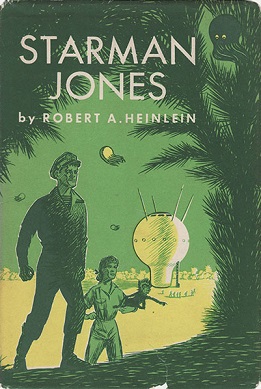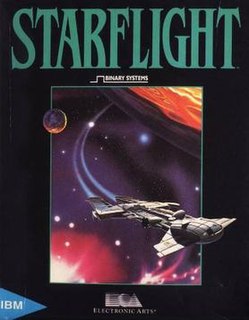In the Star Trek science fiction franchise, the Maquis are a 24th-century paramilitary organization-terrorist group first introduced in the 1994 episode "The Maquis" of the television series Star Trek: Deep Space Nine, and subsequently appearing in Star Trek: The Next Generation and Star Trek: Voyager. The Maquis story debuted when three Star Trek television shows running from the late 1980s to 2001 took place in the same fictional science-fiction universe at the same time in the future. As a result, the Maquis story was told across dozens of episodes with many more shows providing the context in the wider Star Trek narrative.

Starman Jones is a 1953 science fiction novel by Robert A. Heinlein about a farm boy who wants to go to the stars. It was first published by Charles Scribner's Sons as part of the Heinlein juveniles series.

The Spacing Guild is an organization in Frank Herbert's science fiction Dune universe. With its monopoly on interstellar travel and banking, the power of the Guild is balanced against that of the Padishah Emperor as well as of the assembled noble Houses of the Landsraad. Mutated Guild Navigators use the spice drug melange to successfully navigate "folded space" and safely guide enormous heighliner starships from planet to planet instantaneously. Essentially apolitical, the Guild is primarily concerned with the flow of commerce and preservation of the economy that supports them; although their ability to dictate the terms of and fees for all transport gives them influence in the political arena, they do not pursue political goals beyond their economic ones. It is noted in Dune (1965) that Houses of the Imperium may contract with the Guild to be removed "to a place of safety outside the System"; in the past, some Houses in danger of ruin or defeat have "become renegade Houses, taking family atomics and shields and fleeing beyond the Imperium". The Guild controls a "sanctuary planet" known as Tupile intended for such "defeated Houses of the Imperium ... Location(s) known only to the Guild and maintained inviolate under the Guild Peace".

A Guild Navigator is a fictional humanoid in the Dune universe created by Frank Herbert. In this series and its derivative works, starships called heighliners employ a scientific phenomenon known as the Holtzman effect to "fold space" and thereby travel great distances across the universe instantaneously. Humans mutated through the consumption of and exposure to massive amounts of the spice melange, Navigators are able to use a limited form of prescience to safely navigate interstellar space. Control of these Navigators gives the Spacing Guild its monopoly on interstellar travel and banking, making the organization a balance of power against the Padishah Emperor and the assembled noble Houses of the Landsraad.

Starflight is a space exploration, combat, and trading role-playing video game created by Binary Systems and published by Electronic Arts in 1986. Originally developed for IBM PC compatibles, it was later ported to the Amiga, Atari ST, Macintosh, and Commodore 64. A fully revamped version of the game was released for the Sega Genesis in 1991.
"Caretaker" is the pilot episode of the American science fiction television series Star Trek: Voyager. This series premiere was first broadcast as one double-length episode on January 16, 1995, as the first telecast of the fledgling UPN network. It was later split into two parts for syndication, but released in the original one-episode format. Set in the 24th century, the series follows the adventures of the Starfleet and Maquis crew of the starship USS Voyager after they were stranded in the Delta Quadrant far from the rest of the Federation.

Jody Lynn Nye is an American science fiction writer. She is the author or co-author of approximately forty published novels and more than 100 short stories. She has specialized in science fiction or fantasy action novels and humor. Her humorous series range from contemporary fantasy to military science fiction. About one-third of her novels are collaborations, either as a co-author or as the author of a sequel. She has been an instructor of the Fantasy Writing Workshop at Columbia College Chicago (2007) and she teaches the annual Science Fiction Writing Workshop at DragonCon.

Frontier: Elite II is a space trading and combat simulator video game written by David Braben and published by GameTek in October 1993 and released on the Amiga, Atari ST and DOS. It is the first sequel to the seminal game Elite from 1984.

Reach for the Stars is a science fiction strategy video game. It is the earliest known commercially published example of the 4X genre. It was written by Roger Keating and Ian Trout of SSG of Australia and published in 1983 for the Commodore 64 and then the Apple II in 1985. Version 3 added an MS-DOS port, though it did not share all of the features of the other platforms. The game was eventually ported to pre-Mac OS X versions of the Macintosh operating system, such as System 6. It was also ported to the Amiga and Apple IIGS, from the Mac OS version.
"Captive Pursuit" is the sixth episode of the first season of the American science fiction television series Star Trek: Deep Space Nine. The episode was written by executive producer Michael Piller and Jill Sherman Donner, and was directed by Corey Allen.

The Courtship of Princess Leia is a 1994 bestselling Star Wars book by Dave Wolverton. It continued the streak of New York Times Bestsellers, which started with 1991's Heir to the Empire. The Courtship of Princess Leia is set in the Star Wars expanded universe, and deals with the downfall of Warlord Zsinj and the circumstances leading to the marriage of Han Solo and Princess Leia.

Cluster is a series of science fiction novels by Piers Anthony. Anthony originally conceived of and wrote the series as a trilogy but later added two additional volumes.
"Broken Link" is the 98th episode of the science fiction television series Star Trek: Deep Space Nine, the final episode of the fourth season. Odo becomes ill which affects his ability to hold a solid form, so the USS Defiant goes to the Founders' homeworld for a cure.

As one of the brightest stars in Earth's night sky, and the closest-known star system to the Sun, the Alpha Centauri system plays an important role in many fictional works of literature, popular culture, television, and film.

The planetary systems of stars other than the Sun and the Solar System are a staple element in much science fiction. Epsilon Eridani is the fifth-brightest star in the riverine southern constellation of Eridanus. An orange star slightly smaller and less massive than the Sun, and relatively close to the Solar System, it is frequently featured in works of science fiction. It is classified as a type K2 star, with the corresponding suggestion that it has a stable habitable zone and is well suited for life. However, one factor which weakens the case for habitability is its youth—as little as 200 million years old—and consequent high levels of ultraviolet emission.
The planetary systems of stars other than the Sun and the Solar System are a staple element in many works of the science fiction genre.

Empire! is a space combat and trading video game designed by Andrew Glaister and published by Firebird Software in 1986 for the Commodore 64, ZX Spectrum, and Amstrad CPC.
Supernovae in works of fiction often serve as plot devices.

"The Shobies' Story" is a 1990 science fiction novella by American writer Ursula K. Le Guin, describing the story of the first human crew to participate in a newly invented faster-than-light mode of space travel. It was first published in the anthology Universe 1 and subsequently appeared in A Fisherman of the Inland Sea published by Harper Prism in 1994.